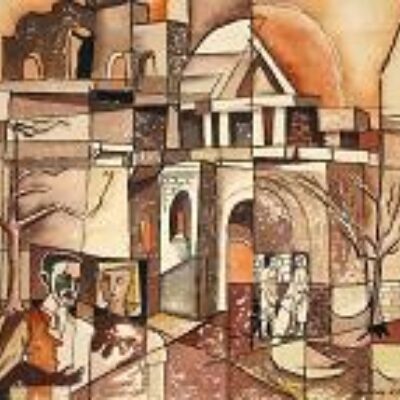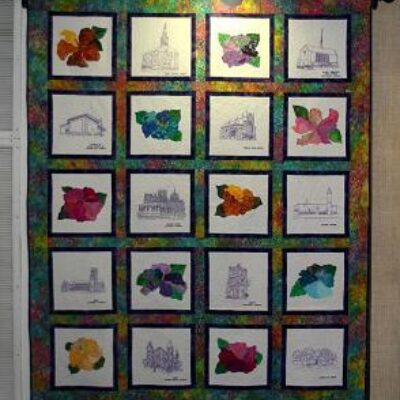An exhibit of inspirational paintings and drawings of churches was displayed at the Rosenberg Library. This unique show featured twenty-five works by six different artists, all but one of whom resided in Galveston. These artists utilized a variety of media — including oil, watercolor, pen-and-ink, and sepia — to create the church depictions. An array of styles is also present, ranging from detailed architectural sketches to abstract cubism. While five of the images are of churches in Galveston, many of the works are of churches the artists visited all around the world.

Ten paintings in the show were done by one of Galveston’s most famous artists, Boyer Gonzales, Sr. (1864 – 1934). Three of these are of Trinity Episcopal Church, where Gonzales was a lifelong parishioner. The other seven works by Gonzales show views of St. Mark Cathedral and Santa Maria della Salute in Venice, Italy. These watercolors were done while Gonzales was on his honeymoon in 1908.
Emil Bunjes (1902 – 1974) produced countless sketches and paintings of Galveston scenes during his life. His pen-and-ink drawings capture some of the city’s most well known sites and structures with great detail. Bunjes’s St. Patrick Church will be easily recognizable to native Galvestonians, and his Chapel at Ursuline Convent depicts a once-beautiful building that was demolished in the late 1960s.
Clyde Harold Wortham (1909 – 1974) was born in Oklahoma but moved to Galveston during his youth. A graduate of Ball High School, Wortham went on to study at the Yard School of Art in Washington, D.C. and the Art Students League in Woodstock, New York. Much of Wortham’s adult life was spent abroad, where he was well known as both a painter and an authority on art restoration. In his miniature painting, The Certosa, Wortham’s talent in capturing the dimensions of light and shadow is evident.

Joseph Alexander Cain (1920 – 1980) is the only artist featured in this exhibit that was not a resident of the Island. Cain was born in Tennesee and served in the U.S. Marine Corps during World War II. After receiving his MFA from the University of California at Berkeley, he began his teaching career in Corpus Christi, Texas. Cain served as chairman of the Art Department at Del Mar College. His cubist watercolor, Mission with Four Figures, was one of the most striking works in the exhibit.

Dr. Merlin McGivney (1905 – 1985) was a long time dentist on the island who had a passion for painting. McGivney was an active member of the Galveston Art League and established an endowment through the Rosenberg Library to fund an annual purchase prize for the league’s juried show. Dozens of original works by McGivney are preserved at the Rosenberg Library, and two of his watercolors — New England Churchand Village in Martinique — were among the most vibrant and eye-catching works in the exhibition.
Dr. Charles Marc Pomerat (1905 – 1964) was a native of Massachusetts who came to Galveston in 1943. Pomerat studied at Harvard and Cambridge before accepting a teaching position at the University of Texas Medical Branch. He was a world-renowned anatomist and cytologist who became interested in art and architecture later in life.

His range of artistic talent was evident in his six works that were included in the exhibit. Pomerat was not only a master of detailed architectural illustration, but he was also able to capture a sense of peaceful ambiance in his fluid watercolor and ink sketches.
Included in the exhibit was a quilt made in 2003 by the Island Quilt Guild, founded in 1991, and which includes the various houses of worship located in Galveston.